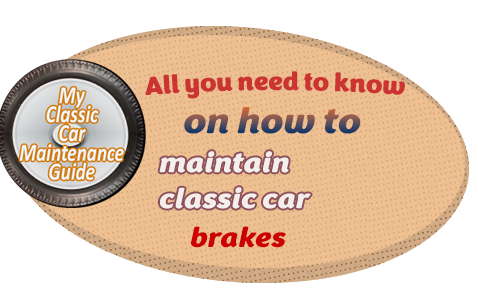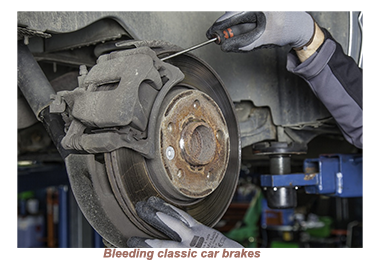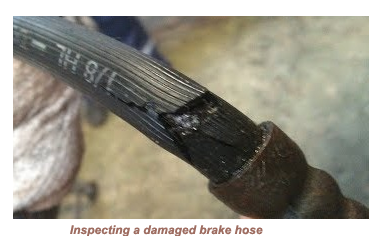
Maintaining the brakes on a classic car is an important part of keeping the vehicle safe and reliable.
The brake system in a car is an essential component, although it is relatively straightforward in design.
Regular maintenance of classic car brakes, especially if the vehicle id being driven often on the open road, will not only minimise potential car accidents but also enhance its durability and efficiency.
Part of any standard maintenance programme should always be to regularly inspect the brake pads, whether the vehicle is fitted with traditional drum brakes or been restored and fited with the more modern disc brakes. Either way, having up-to-date brake pads is crucial for the driver and passenger safety and a comfortable trip.
Not everybody is aware that the brakes occasionally tend to collect moisture over time.
To prevent a braking failure in your historic car, simple checks should be initiated every month or so gauge to wat extent the brake pads have absorbed water, . which reduces brake performance quality and causes corrosion in the system's essential components.
![]()
 It is important to remember that even high-quality and recently restored brake systemswill still require routine maintenance to ensure optimal performance and safety. Implementing regular brake maintenance is crucial.
It is important to remember that even high-quality and recently restored brake systemswill still require routine maintenance to ensure optimal performance and safety. Implementing regular brake maintenance is crucial.
Here are some tips that can help the classic car owner as well as other road users stay safe.
![]() Regularly check the brake pads for wear. If the pads are worn down, they will need to be replaced.
Regularly check the brake pads for wear. If the pads are worn down, they will need to be replaced.
Not everybody is aware that the brakes occasionally tend to collect moisture over time.
To prevent a braking failure in the car, simple checks should be initiated every month or so gauge to wat extent the brake pads have absorbed water, which will reduce brake performance quality and causes corrosion in the system's essential components.
![]() Check the brake rotor for any signs of warping or damage.
Check the brake rotor for any signs of warping or damage.
When a vehicle's brakes are applied, the brake pads press against the rotors, creating friction. This friction causes the wheel's rotation to slow down, ultimately leading to a complete stop of the vehicle's movement.
 Rotors, when new, have surfaces that are smooth and even. Rotors are prone to losing their smooth finish as they age. When the rotors of a vehicle are worn, it can lead to longer stopping distances and a decrease in braking performance. When the rotors of a vehicle are worn, it can lead to longer stopping distances and a decrease in braking performance. If the rotor is damaged, it will need to be replaced.
Rotors, when new, have surfaces that are smooth and even. Rotors are prone to losing their smooth finish as they age. When the rotors of a vehicle are worn, it can lead to longer stopping distances and a decrease in braking performance. When the rotors of a vehicle are worn, it can lead to longer stopping distances and a decrease in braking performance. If the rotor is damaged, it will need to be replaced.
![]() Inspect the brake calipers for any leaks or signs of wear. If the calipers are worn or leaking, they will need to be replaced or rebuilt.
Inspect the brake calipers for any leaks or signs of wear. If the calipers are worn or leaking, they will need to be replaced or rebuilt.
 The brake system in a vehicle is designed to convert the force applied on the brake pedal into stopping power.
This is achieved through filling the hoses with brake fluid, which transmits the pressure from the pedal to the callipers. The callipers then apply pressure to the brake pads, causing them to clamp down on the rotors and slow down the vehicle.
The brake system in a vehicle is designed to convert the force applied on the brake pedal into stopping power.
This is achieved through filling the hoses with brake fluid, which transmits the pressure from the pedal to the callipers. The callipers then apply pressure to the brake pads, causing them to clamp down on the rotors and slow down the vehicle.
![]() Inspect the brake hoses for any signs of wear or leaks. If the hoses are worn or leaking, they will need to be replaced.
Inspect the brake hoses for any signs of wear or leaks. If the hoses are worn or leaking, they will need to be replaced.
![]() Regularly check the brake fluid level and condition. If the fluid is dirty or low, it will need to be changed. Look for any signs of brake fluid leaks around the brake system. If any leaks are found, they will need to be repaired or replaced as soon as possible.
Regularly check the brake fluid level and condition. If the fluid is dirty or low, it will need to be changed. Look for any signs of brake fluid leaks around the brake system. If any leaks are found, they will need to be repaired or replaced as soon as possible.
![]() Inspect the brake lines for any signs of rust, damage or leaks. Any issues with brake lines should be repaired or replaced immediately.
Inspect the brake lines for any signs of rust, damage or leaks. Any issues with brake lines should be repaired or replaced immediately.
![]() Regularly check the brake adjustment to ensure the brakes are not too tight or too loose.
Regularly check the brake adjustment to ensure the brakes are not too tight or too loose.
![]() A process of removing air bubbles from the brake lines in order to ensure proper brake system function, bleeding brakes is typically carried out by opening the brake bleeder valve and allowing brake fluid to flow through the system until all air bubbles are removed.
A process of removing air bubbles from the brake lines in order to ensure proper brake system function, bleeding brakes is typically carried out by opening the brake bleeder valve and allowing brake fluid to flow through the system until all air bubbles are removed.
 Bleeding brakes is an important maintenance task that should be performed regularly to ensure safe and reliable braking performance.
When changing brake fluid, it is essential to bleed the brakes. This process allows for the removal of both the old fluid and any trapped air bubbles, ensuring optimal brake performance. If left unmonitored, these factors have the potential to decrease the hydraulic pressure.
Bleeding brakes is an important maintenance task that should be performed regularly to ensure safe and reliable braking performance.
When changing brake fluid, it is essential to bleed the brakes. This process allows for the removal of both the old fluid and any trapped air bubbles, ensuring optimal brake performance. If left unmonitored, these factors have the potential to decrease the hydraulic pressure.
Routine inspection of fluid levels is important, but it is also recommended to perform regular maintenance by replacing old fluid with new fluid at least once a year or at specified intervals. In the event that the brake fluid appears to be discoloured and contains rubber and rust particles, it is advisable to replace both the brakes and rubber brake lines entirely.
 It is important to note that in some cases, the brake system of classic cars might be different from modern cars, especially drum brake systems and might require special parts or knowledge.
It is important to note that in some cases, the brake system of classic cars might be different from modern cars, especially drum brake systems and might require special parts or knowledge.
As with maintaining any other component in a classic car’s underbody, , it's important to keep in mind that classic cars may require special attention and care when it comes to brake systems, If there is access to an owner's manual it should be taken advantage off. If the necessary skills are not at the owner’s fingertips a professional mechanic to get the specific information and guidance on how to maintain a particular vehicle.
ub4





